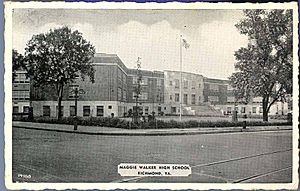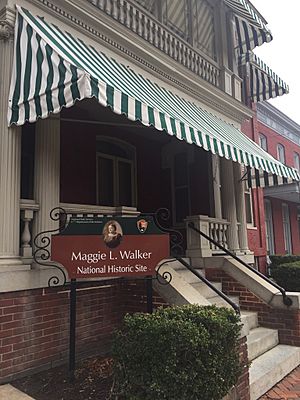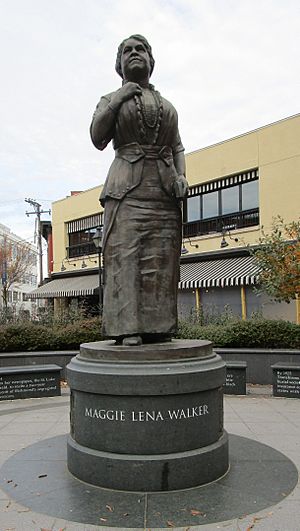Maggie L. Walker facts for kids
Maggie Lena Walker (born July 15, 1864 – died December 15, 1934) was an amazing American businesswoman and teacher. She made history in 1903. Maggie Walker became the first African American woman to start a bank. She was also the first African American woman to lead a bank as its president.
Maggie Walker was a strong leader. She worked hard to make life better for African Americans. Later in her life, she used a wheelchair due to paralysis. This made her an important role model for people with disabilities too.
You can visit her old home in Richmond, Virginia. It is now a special place called the Maggie L. Walker National Historic Site. The National Park Service takes care of it.
Contents
Maggie Walker's Early Life
Maggie Lena Draper was born on July 15, 1864. Her mother, Elizabeth Draper, used to be enslaved. She worked as a cook in Richmond, Virginia. Maggie's mother later married William Mitchell. He was a butler at the same estate.
Maggie and her half-brother, Johnnie, grew up in Richmond. Their home was near the First African Baptist Church. This church was a very important place for the Black community. It was a center for business, politics, and social life. After her stepfather died, Maggie's mother worked as a laundress. Maggie helped her by delivering clean clothes.
Maggie went to the new Richmond Public Schools. When she was 14, she joined a group called the Independent Order of St. Luke. This group helped sick and older people. It also encouraged people to help themselves and be honest.
Maggie Walker as a Teacher
Maggie graduated from the Richmond Colored Normal School in 1883. She then taught at her old school for three years. It was called the Valley School.
Her teaching job ended when she got married. This was because of a school rule. They did not employ married women at that time.
Leading the Independent Order of St. Luke
After leaving her teaching job in 1886, Maggie focused on the Independent Order of St. Luke. She quickly moved up in the organization. By 1899, she became the Right Worthy Grand Secretary. This was the top leadership position.
Maggie worked to challenge unfairness based on race and gender. She was a pioneer in insurance and finance. In 1895, she started the Juvenile Branch of the Order. This branch taught young members about education, helping their community, and saving money.
Starting a Bank: St. Luke Penny Savings Bank
In 1902, Maggie started a newspaper for the organization. It was called The St. Luke Herald. Soon after, she made an even bigger move. She started the St. Luke Penny Savings Bank.
Maggie Walker became the bank's first president. This made her the first African American woman to start a bank in the United States. The bank's building was designed by Charles Thaddeus Russell. He was Richmond's first Black architect. Many women were also on the bank's board of directors.
Later, the St. Luke Penny Savings Bank joined with two other banks. They became The Consolidated Bank and Trust Company. Maggie Walker became the chairman of its board. This bank served Richmond's African American community for many years.
Maggie Walker's Family Life
On September 14, 1886, Maggie married Armstead Walker Jr. He was a brick contractor. They adopted a daughter named Polly Anderson. They also had three sons: Russell Eccles Talmadge, Armstead Mitchell, and Melvin DeWitt. Sadly, Armstead Mitchell died when he was very young.
In 1904, the Walkers bought a home in the Jackson Ward neighborhood of Richmond. This area was a lively African American community. Their home grew over the years to fit their children's families.
Maggie Walker's Lasting Impact
Maggie Walker was recognized as an important leader. In 1905, she was featured on a poster with other famous African American leaders. These included Mary Church Terrell and George Washington Carver.
In 1925, she received an honorary master's degree from Virginia Union University. In 2001, she was added to the Junior Achievement U.S. Business Hall of Fame.
Richmond Public Schools built a large high school in her honor. It was named Maggie L. Walker High School. This school was one of two schools for Black students during the Jim Crow era. Many students went to this school for their high school years. In 2001, it was renovated and reopened as the Maggie L. Walker Governor's School for Government and International Studies.
The St. Luke Building held the offices of the Independent Order of St. Luke. Maggie Walker's office was also there. Her office was kept just as it was when she died in 1934. This building was added to the National Register of Historic Places in 1982.
The Maggie L. Walker National Historic Site is at her old home in Jackson Ward. It became a museum in 1985. The site shows how Maggie Walker lived. It has her original family items. It teaches visitors about her life and the Jackson Ward community.
The National Park Service says that Maggie Walker showed that African American men and women could be leaders. They could lead in business, politics, and education. She proved this even when society tried to say they couldn't.
On July 15, 2017, a statue of Maggie Walker was unveiled in Richmond. It was designed by Antonio Tobias Mendez. The bronze statue is 10 feet tall. It shows her with her glasses on her lapel and a checkbook in her hand. This shows how she lived her life.
In 2020, Maggie Walker was one of eight women featured in a special display. It was called "The Only One in the Room." This display was at the Smithsonian National Museum of American History.






